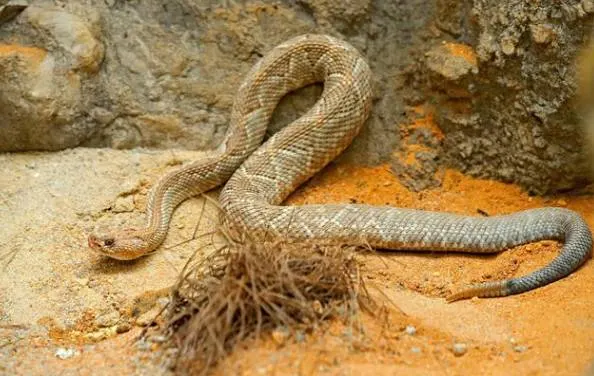The Aruba rattlesnake, scientifically known as Crotalus unicolor, is a fascinating yet critically endangered species that inhabits the arid, rocky terrains of Aruba. This blog post delves into the intriguing aspects of this unique rattlesnake, its habitat, behavior, and the ongoing conservation efforts to protect it.
Table of Contents
Scientific Classification and Conservation Status
- Kingdom: Animalia
- Phylum: Chordata
- Class: Reptilia
- Order: Squamata
- Family: Viperidae
- Genus: Crotalus
- Species: C. unicolor
- Conservation Status: Critically Endangered
The Aruba rattlesnake is one of the rarest rattlesnakes in the world, with an estimated population of only 230 individuals. Conservation efforts are crucial to prevent the extinction of this species, which faces significant threats from human encroachment and habitat loss.

Physical Characteristics
The Aruba rattlesnake typically measures between 2 to 3 feet in length and showcases a variety of colors including blue-gray, light tan, peach, and yellowish hues. These colors often depend on their specific habitat within the island. They possess the distinctive rattles of their genus, made of keratin, and the characteristic spade-shaped head of pit vipers. Their markings are similar to the Eastern diamondback rattlesnake but appear much fainter.
Habitat and Diet
Aruba rattlesnakes are native to the dry, rocky areas of the southeastern half of Aruba. They thrive in cactus and thorn scrub environments where they can effectively ambush their prey. As nocturnal and crepuscular hunters, they primarily feed on small rodents, birds, and lizards, particularly the Aruba whiptail, which is endemic to the island.
Behavior and Interaction with Humans
Despite their venomous nature, Aruba rattlesnakes are mild-mannered and tend to avoid human contact. They inhabit the island’s interior, far from the bustling human settlements along the coast. Their non-aggressive temperament means they rarely bite unless provoked.
Reproduction and Lifespan
Female Aruba rattlesnakes breed roughly every two years, giving birth to live young known as neonates. The gestation period lasts about four months, and each litter consists of 5 to 15 young. These snakes do not venture far from their birthplace, usually staying within a 1-2 square mile range throughout their lives.
7 Interesting Facts About the Aruba Rattlesnake
- Endemic Only to Aruba: The Aruba rattlesnake is found nowhere else in the world, making it a true symbol of the island’s unique biodiversity.
- Critical Endangerment: With less than 230 individuals left, this species is critically endangered, highlighting the urgent need for conservation measures.
- Unique Venom Composition: The Aruba rattlesnake’s venom is a mix of hemotoxins and neurotoxins, similar to the tropical rattlesnake (Crotalus durissus), aiding in both prey immobilization and digestion.
- Conservation Programs: Various zoos worldwide have been involved in captive breeding programs since 1948 to help preserve this species. The San Diego Zoo was the first to successfully breed them in captivity.
- Color Variations: The coloration of these snakes can vary significantly, with individuals found in different areas of the island showing different color patterns.
- Rattle Structure: The rattlesnake’s rattle is composed of loosely interlocking keratin segments that create a distinctive sound to warn predators and humans.
- Low Aggression: Despite their venomous bite, Aruba rattlesnakes are known for their low aggression, often giving dry bites (no venom injected) or using their rattle as a primary defense mechanism.
Conservation Efforts
Conservationists and researchers are working tirelessly to monitor and protect the Aruba rattlesnake. Programs such as the Arikok National Park’s monitoring efforts involve tagging and documenting individual snakes to study their movements, breeding patterns, and health. These programs are vital to understanding the impact of human expansion and introduced species like the boa constrictor on the Aruba rattlesnake population.
Zoos and conservation organizations have implemented species survival plans, focusing on captive breeding and public education to raise awareness about the plight of this rare snake. The ultimate goal is to stabilize and eventually increase the population of Aruba rattlesnakes in the wild.

Challenges Ahead
The Aruba rattlesnake faces numerous challenges, from habitat destruction due to human development to competition with non-native species. Poaching for the illegal pet trade also poses a significant threat. Conservationists must continue their efforts to mitigate these threats through habitat preservation, legal protections, and ongoing research.
The Aruba rattlesnake is not just a fascinating reptile but a critical part of Aruba’s natural heritage. Its survival hinges on continued conservation efforts and increased awareness of its plight. By supporting conservation initiatives and respecting wildlife habitats, we can help ensure that this unique species remains a part of Aruba’s ecosystem for generations to come.
- Enchi Ball Python: A Unique and Stunning Morph of Python regius - March 27, 2025
- Emerald Tree Monitor: The Enigmatic Green Guardian of the Rainforest - March 26, 2025
- The Egyptian Cobra (Naja haje): A Fascinating Serpent - March 25, 2025
